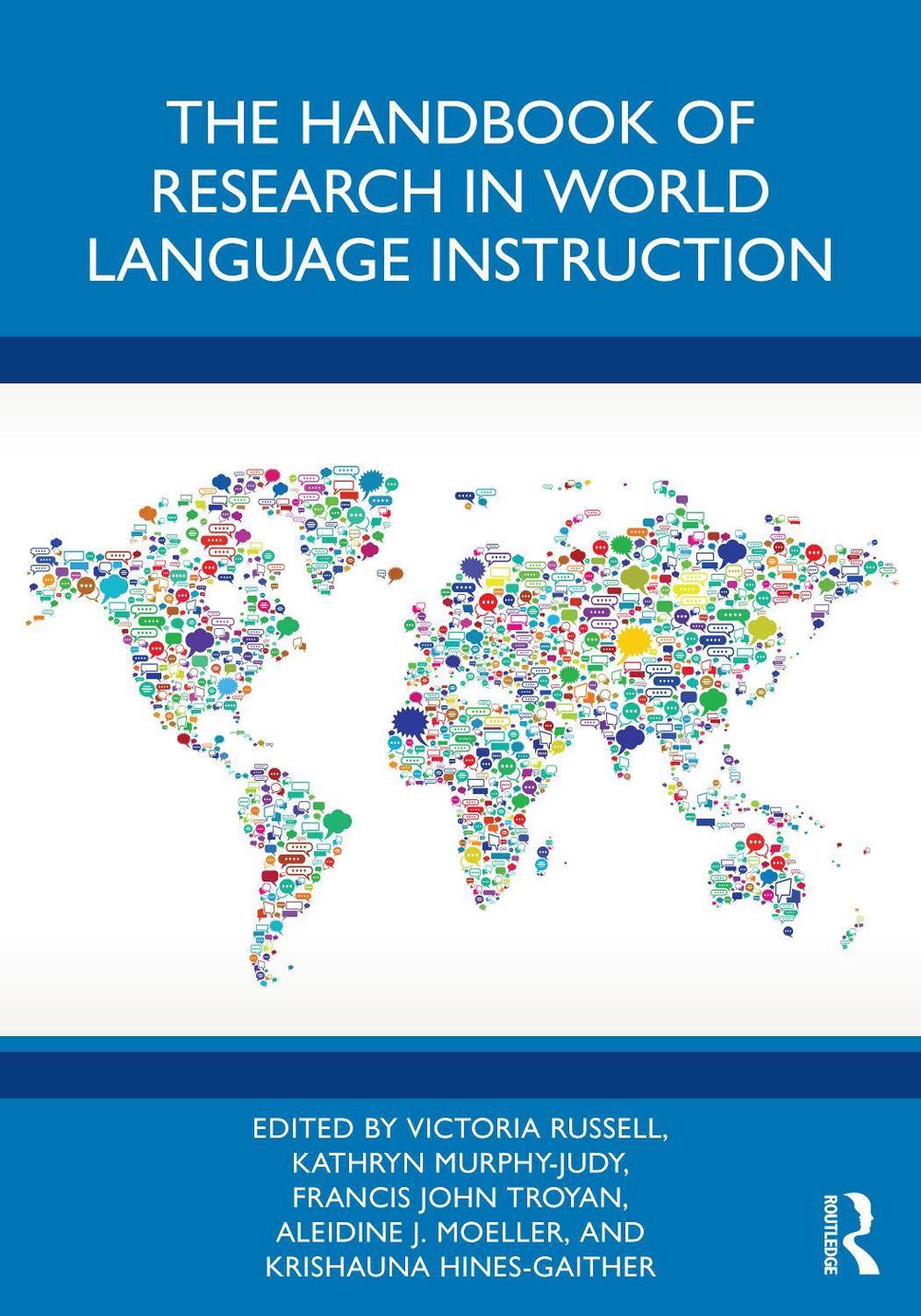
When you click on links to various merchants on this site and make a purchase, this can result in this site earning a commission. Affiliate programs and affiliations include, but are not limited to, the eBay Partner Network.
The Handbook of Research in World Language Instruction by Victoria Russell Paper

- Item No : 236119679804
- Condition : Brand New
- Brand : No brand Info
- Seller : the_nile_uk_store
- Current Bid : US $216.65
-
* Item Description
-
The Nile on eBay

The Handbook of Research in World Language Instruction
by Victoria Russell, Kathryn Murphy-Judy, Francis John Troyan, Aleidine J. Moeller, Krishauna Hines-Gaither
This seminal handbook provides a comprehensive overview of the research on world language education and how that research can transform into effective and daily instructional practices for K-16 language teachers.
FORMAT
PaperbackCONDITION
Brand New
Publisher Description
This seminal handbook provides a comprehensive overview of the research on world language education and how that research can transform into effective and daily instructional practices for K-16 language teachers.With contributions from leading scholars in the field, the volume addresses cutting-edge research, trends, and practice. Covering key topics in language education, the volume is organized in six sections: Teaching Methods and Approaches; Culture, Pragmatics, and Intercultural Communicative Competence; Assessment and Program Evaluation; Diversity, Equity, and Inclusion in the World Language Classroom; Technology Integration and Online Language Teaching and Learning; and Key Issues in World Language Instruction, including advocacy, teacher recruitment and retention, and professional development.This handbook is an essential text for all scholars, researchers, and educators in world languages.
Table of Contents
Part 1: Teaching Methods and Approaches1. Teaching Approaches and Methods in World Language InstructionVictoria Russell 2. ACTFL's Core Practices: The Six Pillars of Effective Language TeachingKate McCrea Francis and Celia Chomón Zamora3. Target Language Comprehensibility in the World Language ClassroomKrista Chambless and Christina Huhn4. Differentiated Instruction: Meeting Student NeedsLeslie Baldwin5. Project-Based Language Learning: Evolution, Design Features, and Research InsightsJulio C. Rodríguez6. Literacy-Based Approaches to World Language InstructionBruna Sommer-Farias and Myriam Abdel-Malek7. Supporting Heritage Learners in the Classroom and BeyondMaria M. Carreira8. Early Language Learning in Dual Language Bilingual Education and Traditional Elementary ClassroomsKatherine Barko-Alva and Paola Mendizábal9. Experiential Learning: Engaging Students in Real-World Language UseTodd A. Hernández with Paul A. GarcíaPart 2: Culture, Pragmatics, and Intercultural Communicative Competence10. Navigating the Multifarious Waters of Intercultural Communication with Learner-Centered Classroom TasksAleidine J. Moeller and Stephanie W. P. Knight11. Centering Communication in ICC: Fostering Target Language Use with Critical Cultural InquiryPaula Garrett-Rucks12. Embrace the Unknown: Interlanguage Pragmatics through Games and PlayJulie Sykes, Sébastien Dubreil, and Stephanie W. P. Knight13. Assessing Intercultural CapabilityAngela Scarino, Michelle Kohler, and Anthony J. Liddicoat14. The Why and How of Teaching for Social Justice and Intercultural Citizenship: Experiences of Early AdoptersManuela Wagner, Terry A. Osborn, and Violet Affleck15. Developing Critical Cultural Awareness and Critical Consciousness in World Language ClassroomsTheresa Catalano and Inoussa Malgoubri16. Intercultural Communicative Competence and Intercultural CitizenshipDorie Conlon and Michael Byram17. Perspective-Making and Its Potential in Intercultural LearningErin Kearney and Tasha AustinPart 3: Assessment and Program Evaluation18. Assessment Competence in World Language EducationLynda Taylor and Beverly Baker19. Proficiency Testing in World Language EducationJ. Dylan Burton and Paula Winke20. Performance Assessment in World Language EducationFrancis John Troyan, Jason Martel, and Anna Zaitseva21. Student Feedback and Uptake in World Language EducationBobby Hobgood22. Dynamic Assessment in World Language EducationAli Kushki and Kristin J. Davin23. Program Evaluation in World Language EducationMargaret E. Malone and Meg MonteePart 4: Diversity, Equity, and Inclusion in the World Language Classroom24. The Antiracist World Language Classroom in the Midst of Opposing DEI LegislationsKrishauna Hines-Gaither and Cécile Accilien25. Educator Agency in World Language Education: A Movement toward Diversity, Equity and InclusionCassandra Glynn and Beth Wassell26. Transdisciplinary Curricular Frameworks for Justice-Centered Pedagogies in the World Language ClassroomL.J. Randolph Jr.27. Teaching Towards Gender Justice: Considerations in Materials Design, Selection, and UseKris Aric Knisely28. Making Invisible LGBTQIA+ Students Visible in World Language CurriculaPaul A. García and James E. Coda29. Supporting Neurodiverse Students in the Secondary World Language ClassroomMeredith McDonald White, Jenniffer Whyte, and Kimberly M. Winslow30. An Antiracist Approach to World Language Assessment: Making the Invisible VisibleTrina Philpot-MontañoPart 5: Technology Integration and Online Language Teaching and Learning31. Technology Integration in Europe: An Experiential ApproachUrsula Stickler and Regine Hampel32. OER and OEP for Second Language Learning and TeachingCarl S. Blyth and Joshua J. Thoms33. Differentiation and Retention: How Flipped Lessons Support Student NeedsLauren Rosen34. Building Connections among World Language Learners with Virtual ExchangeDeniz Gökçora and Raymond Oenbring35. Supporting Less Commonly Taught and Indigenous Languages through Technology Integration and Online Language LearningLuca Giupponi, Emily Heidrich Uebel, Felix A. Kronenberg, and Danielle Steider36. The Maker Movement in World Language EducationGillian Lord37. The Fine Line between Digital Literacy and Academic Dishonesty in Online World Language InstructionErrol O'Neill Part 6: Key Issues in World Language Instruction38. Seal of Biliteracy Implementation in World Language ProgramsKristin J. Davin and Amy J. Heineke39. Engaging World Language Educators in Continuing Professional DevelopmentRebecca Kanak Fox, Kelley E. Webb, and Joan Kang Shin40. The World Language Teacher Shortage and Teacher Retention: Insight and RecommendationsPete Swanson and Jason Fischbach41. The World Language edTPA: Lessons Learned from a National Certification AssessmentSusan A. Hildebrandt42. Indigenous Language Revitalization: Dual Language Immersion in PracticeBrandon T. Locke43. Preparing Students for a Career in Languages: Why World Language Education Programs MatterPatricia W. CumminsConclusion: Future Directions in World Language InstructionPamela M. Wesely, Celia Chomón Zamora, Pablo Muirhead, and Victoria Russell
Details
ISBN1032520280Author Krishauna Hines-GaitherPublisher Taylor & Francis LtdYear 2025ISBN-13 9781032520285Format PaperbackImprint RoutledgePlace of Publication LondonCountry of Publication United KingdomAlternative 9781032529219Edited by Krishauna Hines-GaitherIllustrations 33 Tables, black and white; 12 Line drawings, black and white; 2 Halftones, black and white; 14 Illustrations, black and whiteAudience Tertiary & Higher EducationISBN-10 1032520280DEWEY 418.0071Pages 640Publication Date 2025-06-05UK Release Date 2025-06-05


















